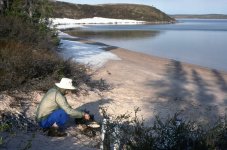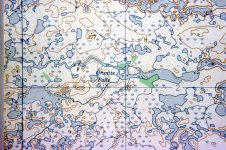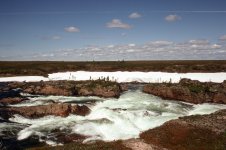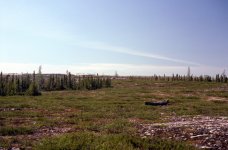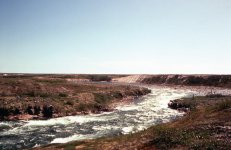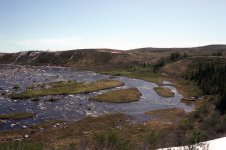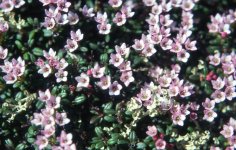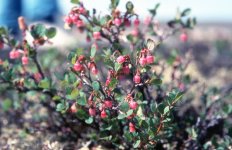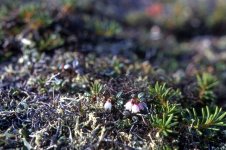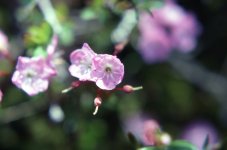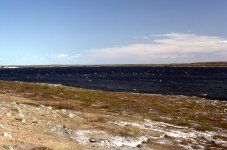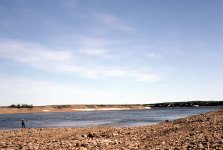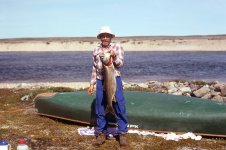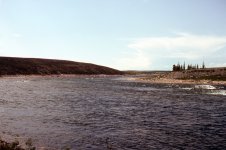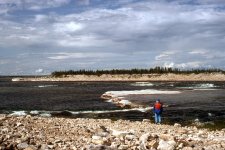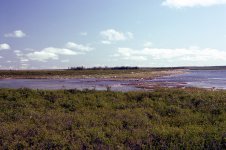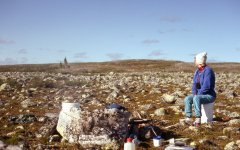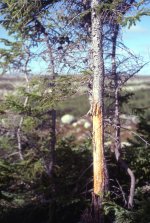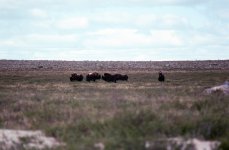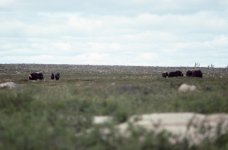This report is re-kindling my desire to do some serious tripping again, it's got everything in it. I'm wondering, did you have your trusty BLR along on this trip?
Mem,
I look forward to your reports of resumed serious tripping! My current report doesn't have everything in it yet. But it's coming. I'm going to post a bit more now, but I'm wondering if people are getting tired of the Thelon River. Not getting very many replies, or the much coveted likes. Anyway, here goes the next three days.
Wednesday, July 7
Up at 6:15 am. The wind blew all night, but has slackened to paddleable conditions. We breakfasted on granola, quickly packed and loaded the canoe, and paddled away an hour later.
Into the wind -- 8-degrees (46 F) -- it was cold. I had on all my gear: wet suit booties, long underwear, shirt, sweater, windbreaker, toque, hat and neoprene paddling gloves. I felt warm, but not toasty. Even the exertion of paddling against the wind didn't generate excess heat.
We reached Eyeberry Lake at 9:00 am. Perhaps we will have a good day, and put some miles behind us. We could hug the west shore, which would buffer us partly from the now brisk NNW wind.
We rounded the point into the Lake, turned north, and gazed across an ocean stretching before us. We could see no end to Eyeberry Lake -- just wind-blown whitecaps rolling toward us from beyond the horizon. Don't think about the destination. It's too daunting. One bay, one point at a time, would get us there. We sneaked down Eyeberry Lake along its 3-m embankment. Comparatively little wind. This will work.
We reached our first bay. Too far across the mouth to traverse in these breakers. We paddled around the point, directly into the wind. Virtually no progress, even though both of us paddled with maximum energy. With each stroke closer to the distant shore, the wind and waves slackened imperceptibly, but assuredly, until we reached the calm, 2-m-high lee shore. Then, broadside to the wind, we sailed down the foot of the bay until we reached the opposite shore and turned out, running before breakers and wind.
"We can do this. This will work. If only that wind would die, dang it!"
By 2:00 pm we had struggled 5 km to the north end of the lake and rode the current through the narrows.
"We win!"
Now we can let the current work for us. Around a bend and into a wide part of the river with a very deep bay extending into the wind. Its opposite shore, only one metre high, offered no wind protection. Rollers piled towards us. We struggled, gained half a canoe length; struggled, gained a quarter canoe length; struggled and lost the battle. Two-thirty. Camp is where your canoe blows to shore.
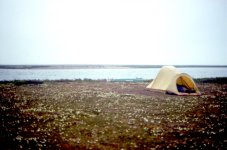
Tonight's home is a low piece of tundra fringed with dwarf birch, which provides sufficient numbers of small sticks to cook our stir-fry with rice. During dinner, the wind stopped, and innumerable magnitudes of small, mosquito-like bugs rose from the birch-clothed tundra. They didn't bite. They simply rose, and with the first breeze, fell to earth, covering our gear, inundating our packs, and generally making a nuisance of themselves. Better than biting mosquitoes, though. (Note: This is a poor image. I just scanned and cleaned it yesterday, as I don't have many images to present in this section of the trip. We didn't take many pictures. We spent most of our time just struggling against the wind.)
The wind has not lessened at all for the last 2 days. Yesterday we woke at about midnight to stand on the beach. Even in the lee of our sand dune, we felt oppressed by the wind, which remained too strong to paddle against. We ate dinner and then slept until 6:00 am. Following a quick breakfast, we began paddling into a blustery, grey morning. After travelling only about 15 km, the wind and waves again forced us to shore, and an early camp near the outlet of Eyeberry Lake. The evening is now calm, but we're both tired. We'll go to bed immediately after dinner, get up early, and try again tomorrow.
In the tent at 6:00 pm. The wind has now slackened substantially. If only it stays that way, we can be on the river at 5:00 am. Assuming we can run all the rapids, we will reach the canyon tomorrow afternoon. I hope so, as we're 45 km (28 miles) behind schedule again, even though we're working very hard.
Thursday, July 8
The wind renewed its attack at 2:00 am, reinforced soon after by rain. "A short storm would be fine. We could still be on the water in sunshine and calm by 5:00 am."
The assault continued at 6:00 am. We were warm and dry, though, in our new tent, designed to withstand all but the most extreme weather conditions. The open vestibule at our head provided ample protection even for the boots and daypack stored outside the sleeping area.
We preferred to sleep with both tent doors open, for ventilation and to be able to scan our environment. I peered through the front door at our feet to confirm that canoe, gear and food had remained undisturbed during the night.
"Oh, no!" Rain had been blowing into the tent for the past four hours. My shirt, sweater, bird and plant books, and the bottoms of our sleeping bags lay soaking in tepid water. What a stupid, careless mistake. I hate such mistakes because they're so easily avoided. The clothes and sleeping bags would dry, but the books would never recover completely.
Our bird and plant books comprise a major part of all our wilderness trips. Although we know most of the common plants by sight, books are necessary to recognize species that are new to us. Without our book, we would never have identified the prickly saxifrage, white petals delicately spotted in orange, growing among the riverside cobbles at the Mary Francis River. Without our bird book, we would never have confirmed the greater white-fronted goose in the pond behind last night's camp in the delta south of Eyeberry Lake. The books will still be serviceable. Their crinkled pages may even be viewed with admiration as having "field character," but I don't like it.
Ten o'clock in the morning, and the rain and wind have continued mercilessly for 8 hours. There's still time for a full day of paddling, even if we leave by two or three. It seems, however, that today is becoming a rest day, even if imposed upon us.
It stormed all night and day. We remained in the tent, very discouraged with our lack of progress. After breakfast of bannock and tea at 6:00 pm, we loaded the canoe, and set out in a calm breeze. We easily completed the crossing of the bay at the north end of Eyeberry Lake and reached moving water, where the wind began to blow again. We stopped at the first bend to scout a rapid marked on the map. We were both very pensive about the wind. Paddling into the wind is not only hard work, but also risky. On a calm river, rocks identify their positions by creating waves. Additional waves made by wind complicate the difficulty of river-reading. A strong wind also forces additional canoe-alignment adjustments when maneuvering around rocks. While waiting for the wind to die down, we walked the entire length of the river bend. Although the wind never slackened, we eventually decided that we needed to run this stretch of river to gain confidence.
Beyond the bend, the river opened into a wide section, where the wind now blew very strongly. As we paddled through the haystacks into the flat water, a large bay opened up on river-right. We suddenly found ourselves far from the safety of shore. I was truly scared as we sought to reach the beach, running in silence before the large waves. We stopped about 12:30 am, ate some soup and retired to the tent. Just before we reached camp, the sky had been nearly completely clear. I now looked out at an almost completely cloud-filled sky. The air is quite cool in the low sun and strong wind. Another storm seems to be blowing toward us. I am so frustrated not to be able to make any progress because of poor weather.
I'm now back in the tent, 20 km (12 miles) past last evening's camp at Eyeberry Lake. Two o'clock in the morning. We're both very tired -- only a cup of soup for dinner. While still at Eyeberry Lake this morning, we played some cribbage, napped a bit, and then made afternoon tea. At 4:00 pm the wind stopped, and soon the rain also stopped. We make a breakfast bannock, and were on the water at 6:00 pm.
It felt good. No wind. At 6:30, a gentle breeze arose.
"I don't like this."
"It's just a breeze," came Kathleen’s response from the bow.
By 7:00 pm, we reached moving water north of Eyeberry Lake, and the wind direction reversed to once again blow directly into our faces. Combined with a fast-flowing current, some rocks, and an approaching rapid, the wind made controlling the canoe difficult. We were off the water at 7:30.
"Oh, well. Time for a tundra hike."
While being harassed incessantly by a peregrine falcon, we strolled very disconsolately down stream, along the cliff, assessing the rapid.
"We could do it easily if it weren't for the wind."
Two hours passed and the gusts grew stronger and more prolonged. For the first time I considered the possibility we would never reach Baker Lake. Maybe we should just run this rapid, wind or no wind.
A few minutes later, Kathleen voiced my thoughts.
"Why can't we run this rapid? Is it only because of the wind? It's one thing to be cautious because we're all alone, but we still have to run what we know we can run."
And so, here we are - - finally beyond Eyeberry Lake - - finally relaxing - - finally enjoying a beautiful evening in low-angle sunlight. Only 40 km and one portage behind schedule. The wind is blowing strongly once again, but I'm a happy guy. I believe we will reach Baker Lake on time.
Friday, July 9
Today began windy, following a noisy, turbulent night of what were probably the strongest winds of the trip so far. While fetching water for breakfast, I was attacked by an Arctic tern. Believing I must be near the nest, I closely watched her retreat. She flew to her nest on an exposed, rocky beach. The tern's colouring makes her very difficult to see, even now that I know where she is. The storm last night was fierce; but, this little bird sits on her nest without any protection from the Arctic winds.
The wind blew very strongly all night, stronger than at any other time on the trip. The noise interrupted our fitful and restless sleep. I'm just glad the tent withstood the unceasing gusts.
We arose at 11:00 am, and found a sheltered spot behind a willow-clothed sand dune to cook a spaghetti breakfast, a meal originally intended for last night’s dinner. The sheltered "kitchen" was quiet -- so nice to be out of the wind.
The sun appeared sporadically from behind the clouds,
and we lingered over the campfire, even taking time to heat water for bathing and washing underwear. It felt good to take off our clothes and bathe in warmth. A short hike over the ridge revealed an American tree sparrow, perched atop a 2-m spruce in a dwarf willow thicket. The bird seemed pleased to be tossed back-and-forth by the wind. I couldn't share its enthusiasm.
At three in the afternoon we put on the water, as the wind dropped to a steady breeze, and the rollers on the large bay no longer broke off-shore. It looked canoeable. We made slow but steady progress along the bay.
"This isn't so bad, but don't tell the wind. We don't want to make it mad."
Ninety minutes later we turned into a 12-km (7.5 miles) arm extending directly north. The wind lay in ambush, and immediately sent breaking waves rolling into our path.
We were making so little progress that we agreed to stop. At 5:00 pm we stood on the shore.
We trudged up a small ridge above a bog, again thinking we'd never reach Baker Lake.
"We can't possibly paddle 12 km directly into this wind."
We lay down in a small depression in the tundra, and were greeted with the pleasingly sweet essence of crushed northern Labrador tea. We also experienced why tundra plants so commonly grow no more than 20 cm (8 inches) high. At their height, we were out of the wind, baking in sunshine and enjoying silence.
After about 20 minutes, we convinced ourselves that the wind was slackening, so we resumed paddling. We made reasonable progress until we rounded a point extending into the lake. Waves crashed over the bow, and we turned to run before them. Driving hard for shore, and leaping out to avoid broaching, we again stood on shore.
We were very depressed to have put so much effort into paddling against the wind, only to make almost no headway.
Once more we trudged back up the ridge, lunch in hand. Chinese noodles steeped in the thermos of water heated at breakfast. Crackers and cheese followed the soup. Kathleen has done an excellent job with the meals, which are certainly highlights of the trip.
As the cheese disappeared, we looked at each other with hopeful disbelief.
"Is the wind really stopping?"
"I think it is!"
Back in the boat for two full hours of paddling into a gentle breeze. Gliding into twilight, periodically circled by a flock of curious old squaws, we finally were able to develop a paddling rhythm. (Note: The Old Squaw duck is now officially called the Long-tailed Duck>)
The wind returned as we neared the first of the marked rapids leading to the Thelon Canyon. We exchanged our light, wooden flat-water paddles for the heavier, more rigid, river paddles, which are far superior at moving and side-slipping the boat in white water.
The first two rapids were only riffles -- almost disappointing. The next five rapids occurred in close sequence on a bend to the right. We eddied out on the inside corner to assess the upper stretch of foam. A ledge followed by a few rocks, with sufficient room to make the necessary moves left, right, and left. We ran it. Then a series of rocks in shallow water, which required only that the canoe be kept parallel with the current. We ran it. Our spirits were high. One rapid to go.
We eddied out on river-right to scout. A serious ledge, with a 2-m souse hole, extending all the way across the river. Through binoculars, we could see a possible sneak route on the distant left bank.
"Can we ferry all the way across without going over the ledge?"
"I think so."
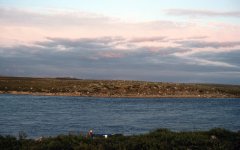
Paddling at 11:30 at night to make up for lost time.
Back in the boat for a must-make ferry. Broad-siding a rock or losing the ferry angle would likely be fatal. The water was not pushy, and we held our position for the 200 m across to the left shore.
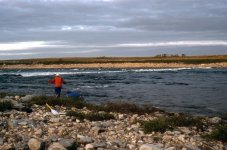
Walking to the ledge revealed about 2 m of runnable water between the shoreline and the vicious souse hole below the ledge.
"It's getting late in the day, and we're tired. Why don't we line it?"
Usually, if you can't run a rapid, you can't line it either. We would have infinitely more control of the boat, in the boat, with paddles in hand. Attempting to guide a boat through rapids only with bow and stern lines held from the shore often results in the canoe turning broadside and broaching on rocks. This rapid was probably runnable, though, with a reasonably clear channel next to shore. We just didn't wish to risk a mistake so close to the souse hole, from which canoe and paddlers might never reappear.
Thirty minutes later, we drifted downstream, in complete calm and perfectly clear skies. Floating into a pink northern horizon, we are happy with today's achievements.
We are now camped at 12:30 am, perched above the Thelon River, about 7 km (4 miles) above the dreaded Thelon Canyon portage. We ran seven of the rapids marked in this section, and are encouraged that maybe we can run some of the Thelon Canyon. Michael lined one rapid tonight - - a ledge that extended almost completely across the river. We are not accustomed to ledges; so far we don't like them. Ledges afford so few canoeing options.
For me, it only takes a few days of living -- in the open -- on the land, before I become enveloped by quiet exhilaration. It is as though the very power of the earth and the wind penetrate to my soul, and I truly never feel so free, so strong, and so alive, as when I am paddling down a wilderness river. If the wind can be unceasing, so can we. If the rapids provide challenges, we can meet them.
Lying in the tent, we hear the muffled thunder of the Thelon Canyon waiting for our descent tomorrow. This tundra landscape seems limitless and supremely powerful. Nonetheless, we feel at home in this landscape, and share its power and limitless possibilities. We are confident that we shall persevere.

